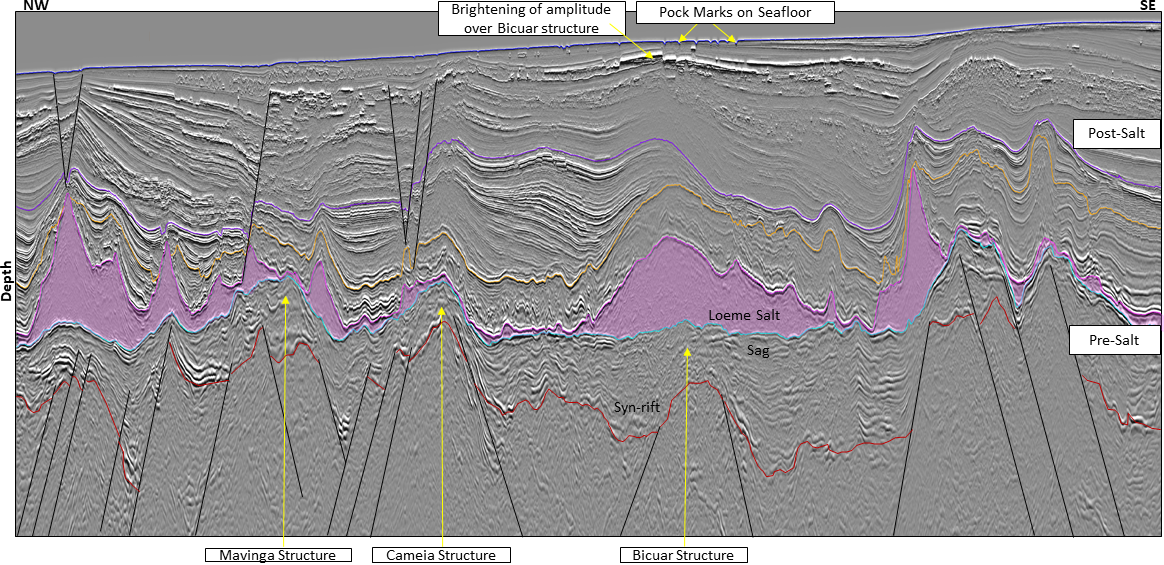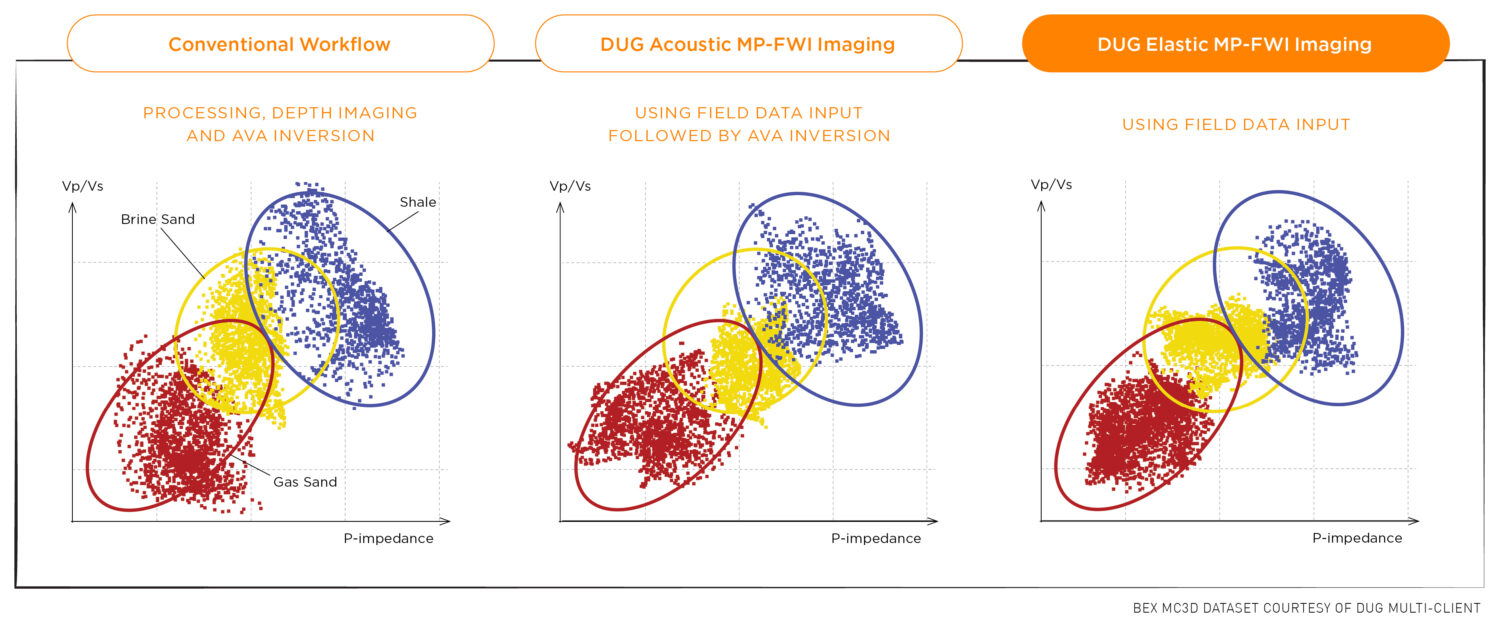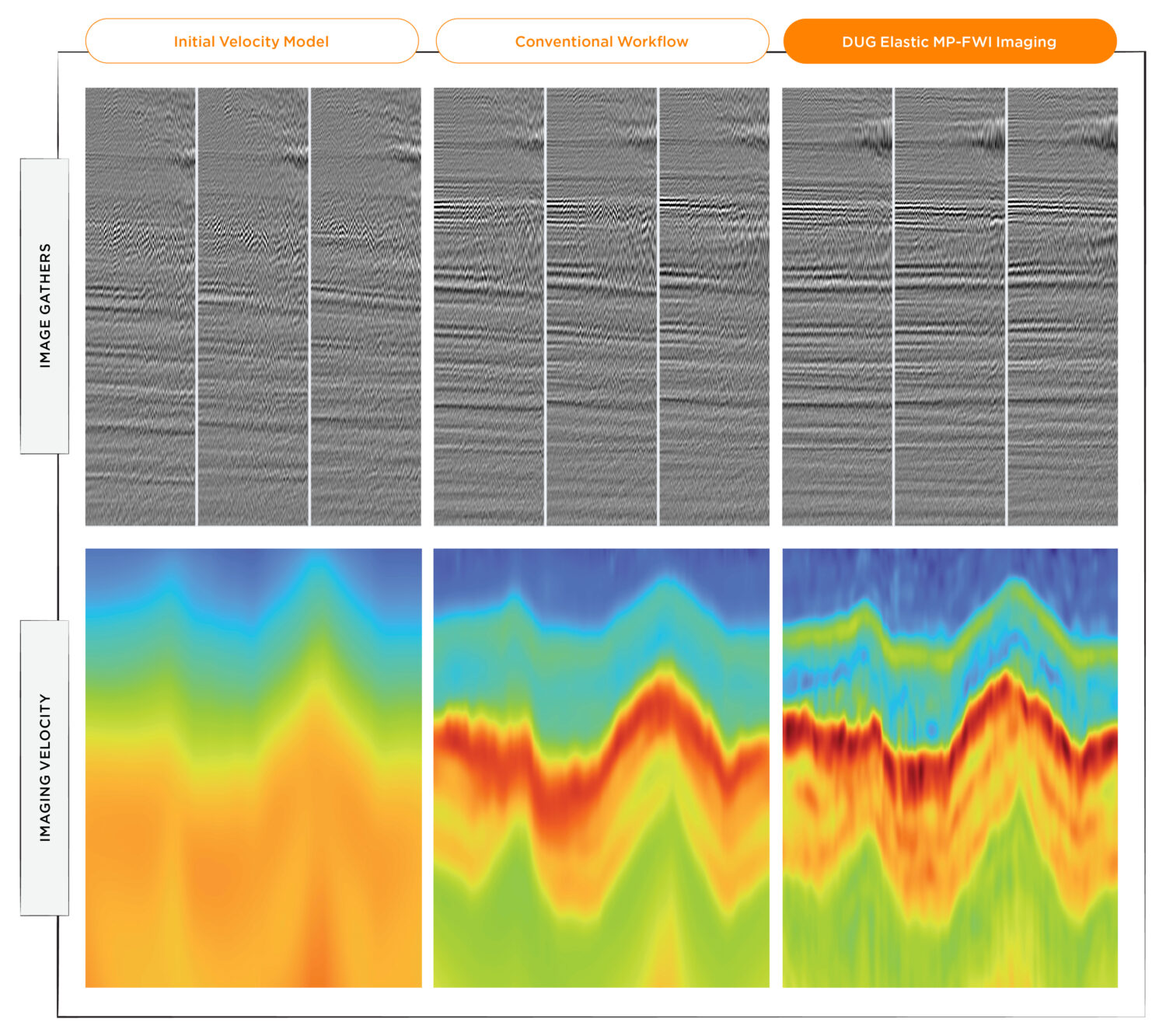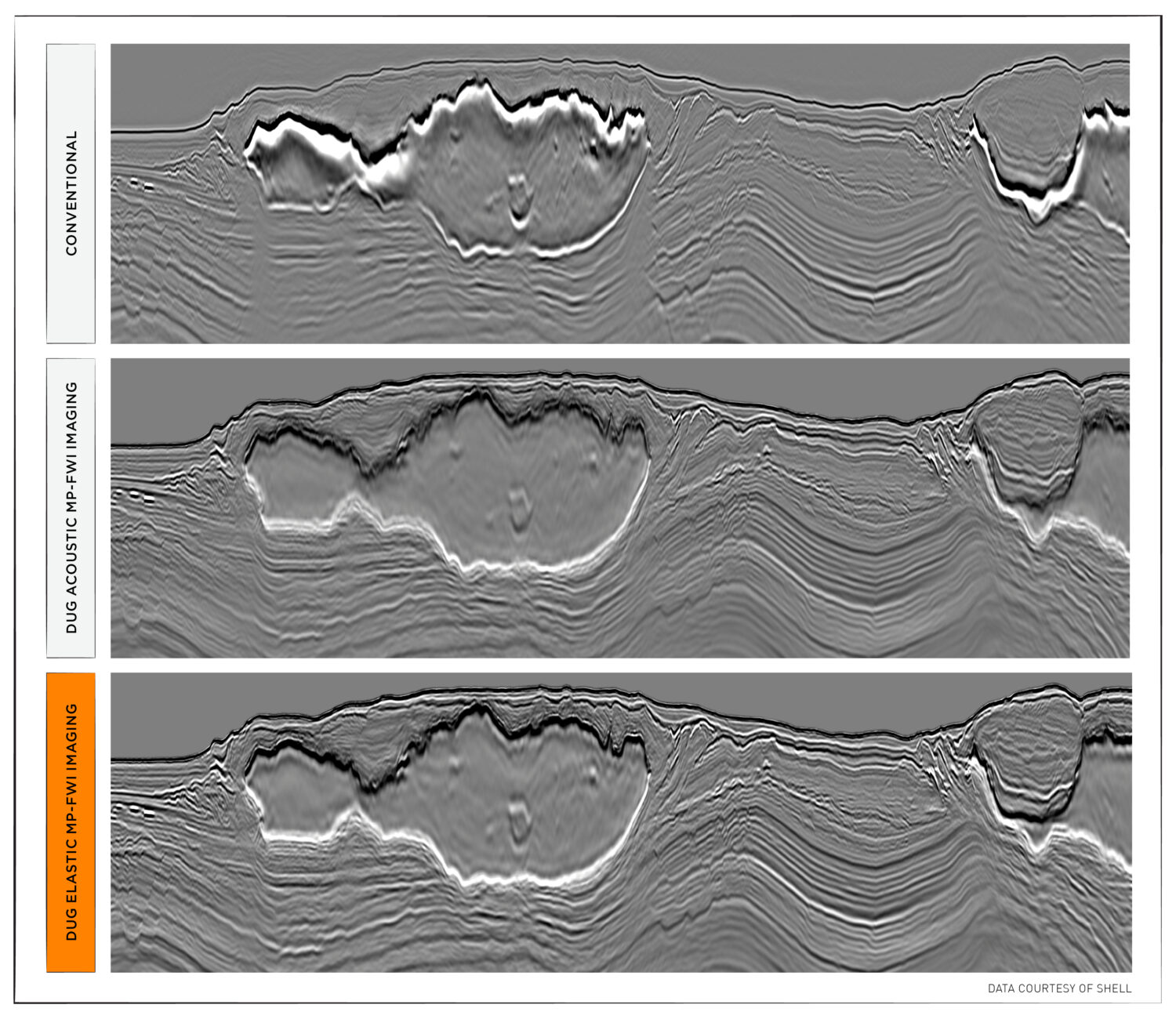Kwanza Basin – a pre-salt success story?
Historically, exploration activity has focused on the prolific Lower Congo Basin in Northern Angola, concentrating on the post-salt Upper Cretaceous and Tertiary reservoirs. The resounding success of Lower Cretaceous Pre-Salt reservoirs in the Santos and Campos Basins of Brazil forced explorers to look at the conjugate West African Kwanza Basin, which shares promising geological similarities across the margin.
Thirteen significant Pre-Salt discoveries were made in the early 2010’s in the Kwanza basin. In Block 21, five exploration wells have been drilled so far. These wells have confirmed the existence of approximately 780-800 MMboe of recoverable reserves. The most significant of these discoveries (Figure 1) was the light oil Cameia-1 discovery in a four-way dip-closed structural trap in an Aptian reservoir with at least 500 meters of closure (Cazier et al., 2014). The well encountered approximately 300 m of gross oil column with over 270 m of net pay in a Pre-Salt carbonate reservoir which is a mixture of chert, dolomite and limestone.

Legacy Dataset
CGG’s Block 21 and 22 broadband 3D multi-client surveys (Figure 1) were acquired in the deep-water Outer Kwanza Basin with a total data coverage of over 7,000 km2. Block 21 survey is located on the exploration trends of the Cameia, Mavinga and Bicuar discoveries. These two datasets are currently being re-processed, and the first phase has now been completed with the re-processing of a sub-set of the Block 21 survey.
Advanced imaging techniques were applied as part of the processing sequence. These included machine learning algorithms for denoise and seismic interference removal, interpretation by fault extraction, and time-lag full-waveform inversion (TLFWI) to produce a more accurate velocity model. The net result is enhanced Pre-Salt imaging and better-defined salt boundaries on the RTM image.
This was followed by further discoveries in the block such as Mavinga and Bicuar. Bicuar was the first syn-rift discovery in the deep-water Kwanza Basin and encountered 56 m of net pay. Currently, the Cameia discovery is expected to start production in 2025, and development will involve the drilling of approximately five wells, including an FPSO and subsea trees.
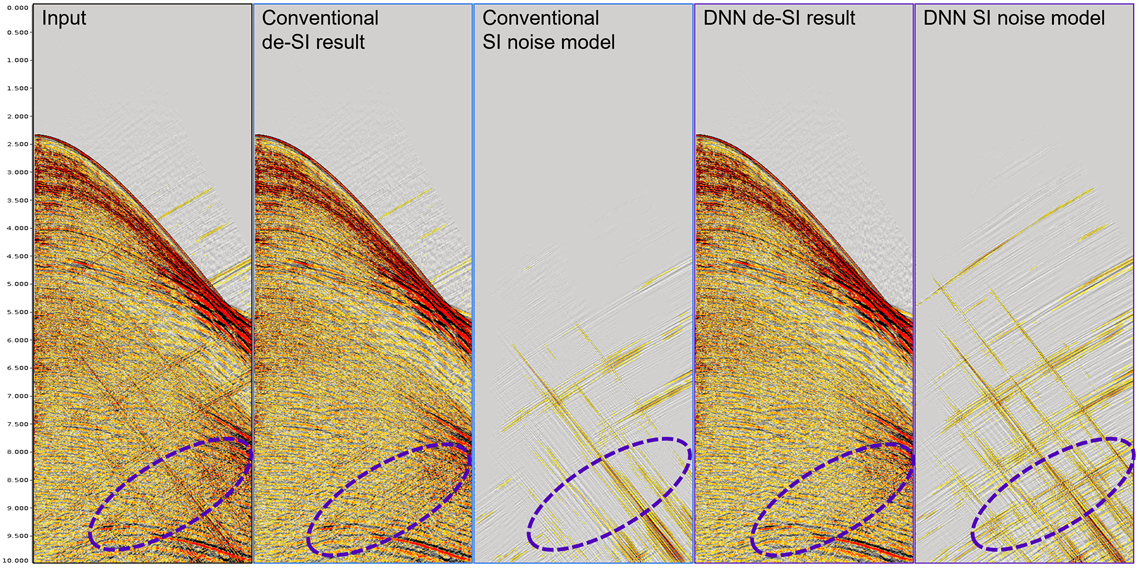
The pre-salt play of Kwanza Basin
All the key elements of a working petroleum system are present within the Pre-Salt (Figure 2). The play consists of Barremian type I oil-prone source rocks of the Bucomazi Formation which were deposited in deep anoxic lakes charging the Pre-Salt reservoirs. The sag interval is characterised by carbonate deposition in restricted alkaline lacustrine settings. These excellent reservoirs have been proven in both the Cameia and Mavinga discoveries. Oil generation probably began in the deeper parts of the syn-rift graben during or after late sag deposition (Saller et al., 2016). The regional Loeme salt along with tight carbonate layers deposited over the Pre-Salt unit act as an excellent vertical regional seal. In addition to these carbonate reservoirs, deeper sag and syn-rift sands of the Cuvo Formation act as the secondary reservoirs within the Pre-Salt section.
Seismic imaging challenges
The latest proprietary pre-processing, velocity model building and imaging algorithms were applied to generate a high-quality image for improved prospect mapping. Starting from raw vintage data allowed for the implementation of the latest advances in pre-processing technology to tackle existing challenges at the source, most notably high-frequency multiple suppression using a targeted de-multiple modelling and subtraction workflow, as well as attenuation of the complex receiver ghost from the variable-depth streamer with 3D de-ghosting algorithms.
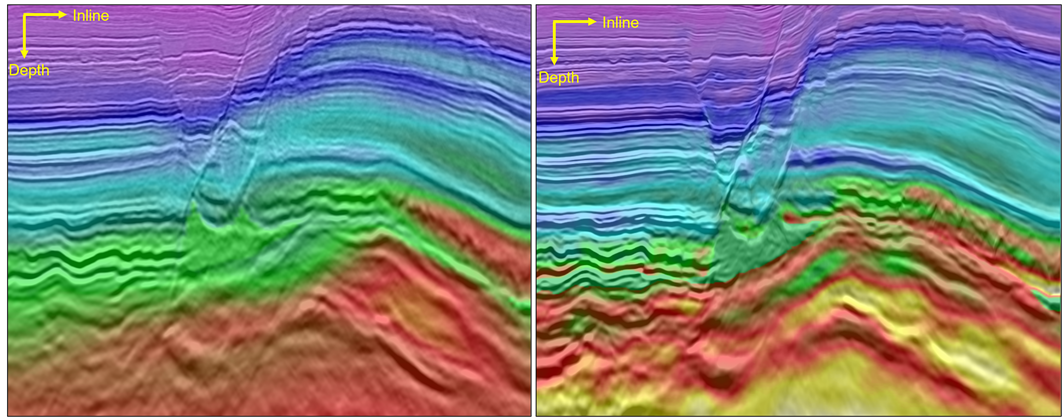
An additional requirement was fully addressing the seismic interference (SI) noise caused by other seismic vessels conducting acquisition in the area as well as coherent noise from numerous and unchecked local fishing vessels, an ever-present issue offshore Angola. To attenuate this noise, an innovative machine-learning algorithm was designed using a trained Deep Neural Network (DNN). The DNN flow (Sun et al., 2022) outperformed conventional de-noise methods, particularly in areas of comparable amplitude between primary signal and noise (Figure 3).
With the newly pre-processed data available, the biggest challenge still had to be overcome: generating a detailed velocity model for final imaging in a geological setting with strong fault-bounded velocity contrasts from layered carbonates and salt. To this end, TLFWI (Wang et al., 2019) was utilised as the main model-building tool. The algorithm employs a cross-correlation-based cost function to measure travel time differences between real and synthetic data. This allows it to mitigate the amplitude and cycle-skipping issues plaguing conventional FWI algorithms at strong impedance contrasts, e.g. salt-sediment and carbonate-sediment boundaries.

The TLFWI update provided both the layered and localized detail required to represent this geological setting (Figure 4). It proved particularly effective in resolving the velocity contrasts arising between the layered carbonate sequences, even in areas with a contrast greater than 1500 m/s over 50 m between layers. In addition, the use of reflections as part of the full wavefield in TLFWI allowed for an accurate update of velocities in the Pre-Salt, capturing both the sag sequences and reservoir packages in the velocity field. Final depth imaging gave an improved structural understanding of the base salt and deeper faulted structures (Figure 5), with well-tie analysis showing notable improvements in reservoir depth position.
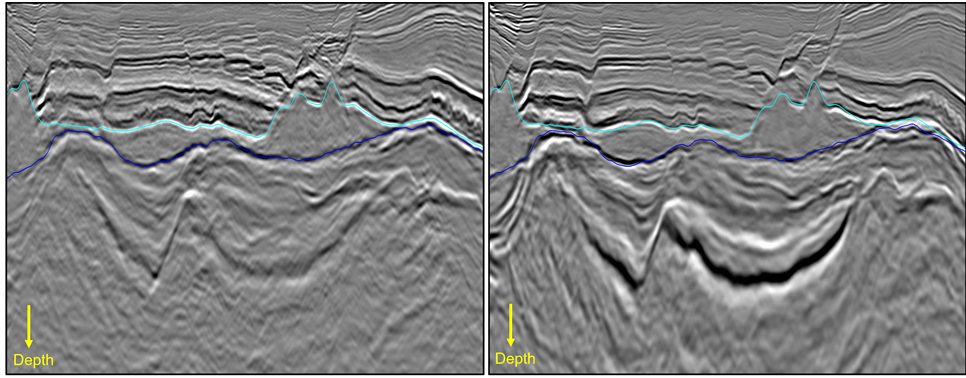
New exploration opportunities
This newly re-imaged dataset opens the door for a fundamental re-assessment of the Pre-Salt system present in the Kwanza Basin. An arbitrary line through the Mavinga and Cameia wells in the area (shown in Figure 6) highlights the improved resolution of the sag carbonate reservoirs. The base salt is better focused and more easily trackable. In addition, previously weak and fragmented syn-rift sands were revealed. The re-processing now allows for a re-assessment of this deeper secondary reservoir in the promising Kwanza basin.
References
Cazier, E., Bargas, C., Buambua, L., Cardoso, S., Ferreira, H., Inman, K., Lopes. A., Nicholson, T., Olson, C., Saller, A. & Shinol, J., 2014. Search and Discovery article no. 20275.
Saller, A., Rushton, S., Buambua, L., Inman, K., McNeil, R & Dickson, J.A.D, 2016. Presalt stratigraphy and depositional systems in the Kwanza Basin, offshore Angola. AAPG Bulletin, v. 100, n. 7, p. 1135-1164.
Sun, J. & Hou, S., (2022). Improving signal fidelity for deep learning-based seismic interference noise attenuation. Geophysical Prospecting, Wiley Online Library.
Wang, P., Zhang, Z., Jiawei, M., Lin, F. & Huang R (2019) Full-waveform inversion of salt: A coming of age. The Leading Edge, 38, no. 3, 204-213.

